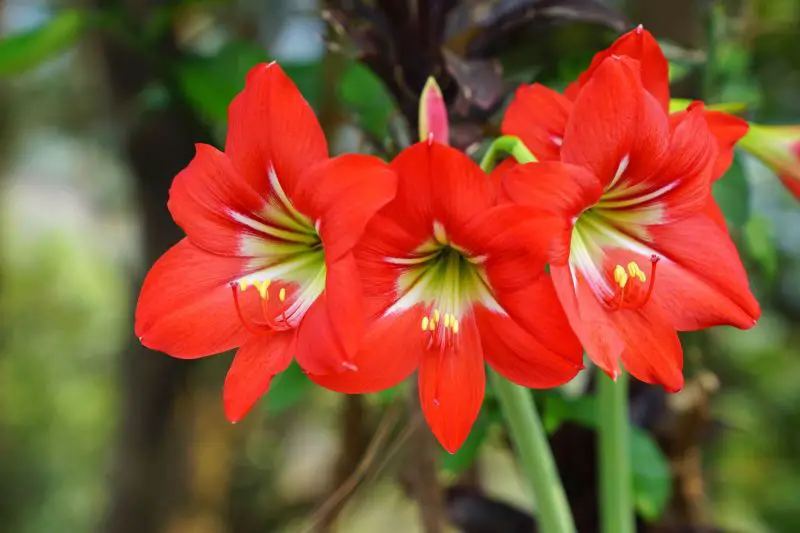Introduction
Amaryllis is renowned for its vibrant, trumpet-shaped flowers that brighten up homes during the winter months. While the initial bloom is relatively easy to achieve, many plant owners struggle to make their amaryllis rebloom the following year. Understanding the plant’s natural cycle and tailoring care throughout the year are key factors in encouraging repeat flowering. This guide will walk you through expert techniques to promote healthy regrowth and stunning future blooms.
Understanding the Amaryllis Lifecycle

Amaryllis follows a unique lifecycle, alternating between active growth, flowering, and dormancy. The plant grows from a bulb and typically produces flowers in winter. Once the flowers fade, the plant shifts into a foliage-growing phase, where it builds energy reserves for the next blooming cycle. Eventually, it enters dormancy, a critical resting period required for future blooms.
The Importance of Post-Bloom Care
Once the flower stalk has faded, cutting it back is essential, but the green leaves should remain. These leaves perform photosynthesis, storing energy in the bulb for the next bloom. Continue placing the plant in a bright location and water it consistently during this phase. Fertilizing with a balanced, water-soluble formula every few weeks can greatly enhance bulb strength.
Maximizing Leaf Growth After Blooming
The post-bloom period is not the time to neglect your amaryllis. Encouraging lush leaf growth is essential because the bulb gathers nutrients through the foliage. Place the plant near a sunny window, ideally with at least six hours of indirect sunlight daily. Consistent watering and fertilization throughout spring and early summer will help the bulb store enough energy to produce another round of flowers.
When and How to Induce Dormancy
By mid to late summer, it’s time to gradually prepare the amaryllis for dormancy. Begin by reducing watering slowly. The leaves will naturally begin to yellow and die back—this is normal. Do not force the leaves to fall off; let them wither naturally. Once all the leaves are spent, cut them off close to the bulb.
After leaf removal, move the pot to a cool, dark place. A closet, basement, or unheated garage with temperatures between 50–55°F (10–13°C) is ideal. The plant should stay in dormancy for about 8 to 10 weeks. Avoid watering during this time, and do not apply any fertilizer.
Bringing Amaryllis Out of Dormancy
After the rest period, check the bulb for signs of life—usually a small green shoot will emerge. At this point, bring the pot back into a warm, bright environment. Begin watering lightly. As growth resumes, gradually increase the watering frequency. Avoid overwatering in the early stages, as the bulb is still vulnerable to rot.
Repotting and Soil Refreshment
You don’t necessarily need to repot amaryllis every year, but doing so every two to three years can improve bulb health. Choose a pot with good drainage and a slightly snug fit—about an inch wider than the bulb on all sides. Use a well-draining potting mix, ideally enriched with organic matter. When repotting, leave about a third of the bulb above the soil surface.
Light Requirements During Regrowth
As the amaryllis exits dormancy, adequate light is essential for strong stem and flower development. A sunny windowsill or a spot with filtered light is best. Rotate the pot regularly to promote straight, even growth. Insufficient light may result in leggy, weak stems or failure to bloom altogether.
Watering Strategy for Reflowering
Proper watering is a balance. After dormancy, start with minimal moisture and increase as the shoot and leaves develop. Once the flower stalk appears, maintain slightly moist soil—but never soggy. Let the top inch of soil dry before watering again. Overwatering, especially in low-light conditions, can lead to bulb rot and fungal issues.
Fertilizing Schedule to Boost Bloom Potential
Feeding is crucial in the regrowth and post-bloom phases. Use a balanced fertilizer (such as 10-10-10 or 20-20-20) every 2 to 4 weeks during the active growing season. Stop fertilizing as you begin the dormancy preparation in late summer. Consistent feeding helps the bulb store ample energy to support another blooming cycle.
Recognizing Blooming Readiness
Not all bulbs will rebloom in exactly one year—it depends on how well they’ve stored energy. Signs that a bulb is ready include the emergence of a thick, central stalk, usually before or along with new leaves. Smaller bulbs or those that didn’t get enough post-bloom care may skip a year but will bounce back with consistent treatment.
Common Challenges and How to Overcome Them
If your amaryllis isn’t reblooming, don’t be discouraged. A few common issues may be to blame:
- The bulb may not have received enough light during its active phase.
- Overwatering or underwatering could have stressed the plant.
- The bulb might not have had a sufficient dormancy period.
- Fertilization may have been inadequate or inconsistent.
Carefully revisiting each phase of the lifecycle and making small adjustments can dramatically improve your success rate.
Outdoor vs Indoor Reblooming
If you live in a warm climate (USDA zones 8–11), amaryllis can grow outdoors year-round. In this case, the bulb’s dormancy might be less dramatic, but it can still rebloom naturally. Indoors, you’ll need to simulate seasonal changes more deliberately. In both environments, regular observation and gentle intervention are the keys.
Propagating Offsets for Future Blooms
Over time, mature amaryllis bulbs produce small side bulbs known as offsets. These can be separated during repotting and planted individually. While it may take a few years for offsets to flower, they represent a great way to propagate new plants. Each offset needs to develop a strong root system before it can support flowering.
Year-Round Care Calendar for Reblooming Success
Winter: Enjoy blooms, keep in a cool but bright location, water moderately.
Spring: Cut back flower stalk, allow leaves to grow, fertilize regularly.
Summer: Maintain light and water, prepare for dormancy by slowly reducing care.
Fall: Induce dormancy in a cool, dark place. Stop watering.
Late Fall to Early Winter: Reintroduce light and warmth. Resume watering and begin new cycle.
Frequently Asked Questions
How long does it take for amaryllis to rebloom?
The time it takes depends on how well the bulb was cared for during the previous season. Generally, if dormancy and regrowth are properly managed, amaryllis can rebloom in about 8 to 10 weeks after dormancy ends.
Can I leave my amaryllis in the same pot every year?
Yes, as long as the pot provides enough room for the bulb and offers proper drainage. However, refreshing the soil every two to three years helps maintain nutrient balance and prevents compaction.
What should I do if my amaryllis only grows leaves and no flowers?
This usually means the bulb didn’t store enough energy during the previous growing season. Focus on maximizing leaf growth and fertilization during the next cycle. Ensure the plant receives ample light and regular feeding.
Should I refrigerate my amaryllis bulb to force dormancy?
Refrigeration is not necessary and not recommended unless you live in a very warm climate without a cool resting place. Instead, simply store the bulb in a cool, dark location for 8 to 10 weeks.
How can I tell if my amaryllis bulb is still alive?
A healthy bulb feels firm and heavy. If it appears mushy or hollow, it may have rotted. Look for signs of green shoots or root development after dormancy as indicators of viability.
Final Thoughts
Reblooming an amaryllis is not a matter of luck—it’s a process that relies on thoughtful, year-round care. By understanding each stage of the plant’s lifecycle and responding accordingly, you can coax your amaryllis to produce brilliant flowers year after year. With patience, consistency, and a little practice, your amaryllis can become a long-lived, reliable showpiece in your indoor garden.






